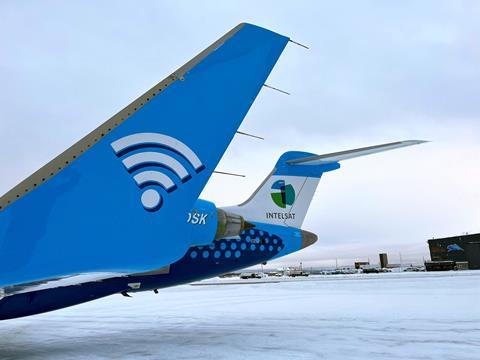Demand for inflight connectivity has blossomed and increased exponentially over the last 15 years. Passengers are connecting more powerful devices, streaming copious amounts of content, accessing dynamic websites, and using data-rich applications that require higher bandwidth, lower latency, and continuous connectivity.
As mobile device technology has evolved, so has supporting inflight connectivity infrastructure. Through it all, one constant has remained: Intelsat’s leadership and presence at the forefront of inflight connectivity innovation.

From the first Ku-band systems to the introduction of 2Ku service powering speeds of over 100 Mbps, to its landmark acquisition of Gogo in 2020, Intelsat’s passion for and commitment to innovation helps its airline partners meet the demands of business and leisure customers who expect a similar connectivity experience at 35,000 feet as they have on the ground.
Now, Intelsat has unveiled the latest significant milestone innovation for commercial aviation - multi-orbit connectivity. This new capability ensures airlines can deliver “non-stop service” across all routes, at all times, around the world.
Intelsat combines capacity from its owned fleet of proven, reliable, and resilient geostationary satellites with the low latency and global coverage offered by OneWeb’s low-Earth orbit constellation, integrated into one seamless solution. With access to capacity from both networks made possible via a lower-profile and lighter-weight electronically steered antenna, Intelsat ensures airline passengers have the right amount of bandwidth for any connected application, whether sending and receiving emails, browsing the internet, or streaming entertainment content.

With a multi-orbit network, airlines can deliver a dramatically enhanced onboard connectivity experience. Whether operating over polar regions, on the fringes of the network, or in high-traffic areas where congestion can potentially limit speeds, airlines can access the best network to maintain the highest quality of service. Each network also offers redundancy for the other, ensuring uninterrupted connectivity in the unlikely event an individual satellite or element of the network is disrupted.

For Intelsat, “non-stop service” also means a never-ending pursuit of innovation and evolution to improve connectivity technology. For example, airlines using today’s multi-orbit solution may pre-determine the appropriate time to switch from one network to another based on geographic considerations. Soon, new algorithms and terminals at the edge will automate network switching, informed by real-time performance as well as current and predicted utilization of each network.
The forthcoming launch of software-defined satellites, capable of dynamically allocating the right amount of bandwidth with fewer interruptions to service and at a lower cost, will deliver ever greater speeds and value.
Airlines understand the value inflight connectivity brings to their business. Passengers will choose the airline that offers a superior experience. Intelsat’s commitment to innovation ensures that its airline partners can meet the ever-increasing demands for premium connectivity and deliver an inflight experience that boosts both loyalty and the bottom line today and into the future.
Learn more about Intelsat’s non-stop innovation.
















































